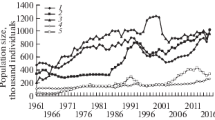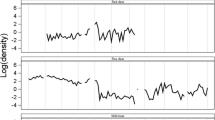Summary
Changes in populations of several ungulate species in the Serengeti-Mara region of East Africa over the past 30 years suggest several hypotheses for their regulation and coexistence. Recent censuses in the 1980s have allowed us to test the hypotheses that: (1) there was competition between wildebeest (Connochaetes taurinus) and Thomson's gazelle (Gazella thomsoni). This predicted that gazelle numbers should have declined in the 1980s when wildebeest were food limited. Census figures show no change in gazelle numbers between 1978 and 1986, a result contrary to the interspecific competition hypothesis; (2) wildebeest and African buffalo (Syncerus caffer) populations were regulated by intraspecific competition for food. Since both populations reached food limitation in the 1970s, the hypothesis predicted that the populations should have been stable in the 1980s. The results confirm these predictions for wildebeest and the buffalo population in the Mara reserve. In the Serengeti the buffalo population declined 41% over the period 1976–1984. The decline was not evenly distributed over the park, some areas showing an 80–90% decline, others no change or an increase in numbers. The decline was associated with proximity to human habitation; (3) an outbreak of the viral disease, rinderpest, in 1982 may have been the cause of the drop in buffalo population. Blood serum samples to measure the prevalence of antibodies were collected from areas of decreasing, stable and increasing populations. If rinderpest was the cause of decrease there should be a negative relationship between the prevalence of rinderpest and the instantaneous rate of increase (r). The results showed no relationship. We conclude that rinderpest was not the major cause of the drop in buffalo numbers. Elephant (Loxodonta africana) numbers dropped 81% in Serengeti in the period 1977–1986. In the Mara there was little change. The evidence suggests that extensive poaching in northern and western Serengeti during 1979–1984 accounted for the drop in both elephant and buffalo numbers.
Similar content being viewed by others
References
Anderson J, Rowe LW (1982) The use of an enzyme-labelled assay as an aid to reading micro-virus neutralization tests. J Immunol Meth 53:183–186
Borner M, FitzGibbon CD, Borner M, Caro TM, Lindsay WK, Collins DA, Holt ME (1987) The decline of the Serengeti Thomson's gazelle population. Oecologia 73:32–40
Borner M, Maragesi B (1985) Land use pressure around the Serengeti National Park. Tanzania National Park, p 30
Darling FF (1960) An ecological reconnaissance of the Mara Plains in Kenya Colony. Wildl Monogr No 5 The Wildlife Society, Washington, DC
Dublin HT, Douglas-Hamilton I (1987) Status and trends of elephants in the Serengeti-Mara ecosystem. Afr J Ecol 25:19–33
Grimsdell JJR (1973) Age determination of the African buffalo, Syncerus caffer Sparrman. E Afr Wildl J 11:31–54
Grzimek M, Grzimek B (1960) Census of plains animals in the Serengeti National Park, Tanganyika. J Wildl Manage 24:27–37
Norton-Griffiths M (1973) Counting the Serengeti migratory wildebeest using two-stage sampling. E Afr Wildl J 11:135–149
Norton-Griffiths M (1978) Counting animals. 2nd Ed African Wildlife Foundation, Nairobi, Kenya
Plowright W (1987) Investigations of rinderpest antibody in East African wildlife, 1967–1971. Rev Sci Tech Off Int Epiz 6:497–513
Sinclair ARE (1973) Population increases of buffalo and wildebeest in the Serengeti. E Afr Wildl J 11:93–107
Sinclair ARE (1974) The natural regulation of buffalo populations in East Africa. IV The food supply as a regulating factor, and competition. E Afr Wildl J 12:291–311
Sinclair ARE (1977) The African Buffalo. University of Chicago Press, Chicago
Sinclair ARE (1979) The eruption of the ruminants. In: Sinclair ARE, Norton-Griffiths M (eds) Serengeti: Dynamics of an ecosystem. University of Chicago Press, Chicago, pp 82–103
Sinclair ARE, Norton-Griffiths M (1982) Does competition or facilitation regulate migrant ungulate populations in the Serengeti? A test of hypotheses. Oecologia 53:364–369
Sinclair ARE, Dublin H, Borner M (1985) Population regulation of Serengeti wildebeest: a test of the food hypothesis. Oecologia 65:266–268
Stewart DRM, Talbot LM (1962) Census of wildlife on the Serengeti, Mara and Loita plains. E Afr Agric For J 28:58–60
Talbot LM, Talbot MH (1963) The wildebeest in western Masailand. Wildl Monogr No 12 The Wildlife Society, Washington, DC
Author information
Authors and Affiliations
Rights and permissions
About this article
Cite this article
Dublin, H.T., Sinclair, A.R.E., Boutin, S. et al. Does competition regulate ungulate populations? Further evidence from Serengeti, Tanzania. Oecologia 82, 283–288 (1990). https://doi.org/10.1007/BF00323546
Received:
Accepted:
Issue Date:
DOI: https://doi.org/10.1007/BF00323546




